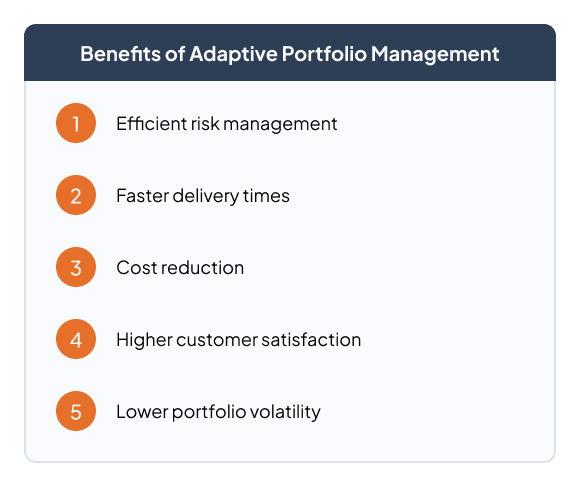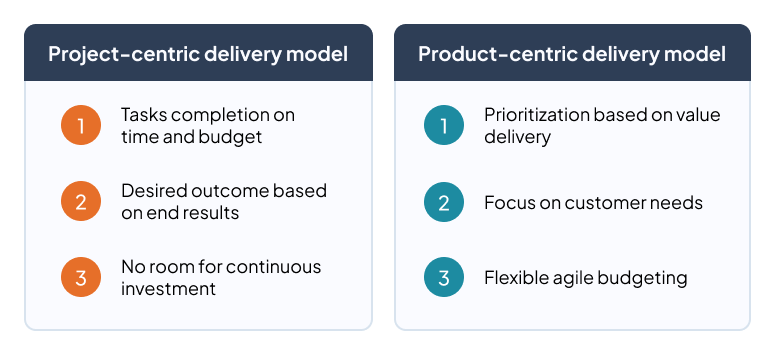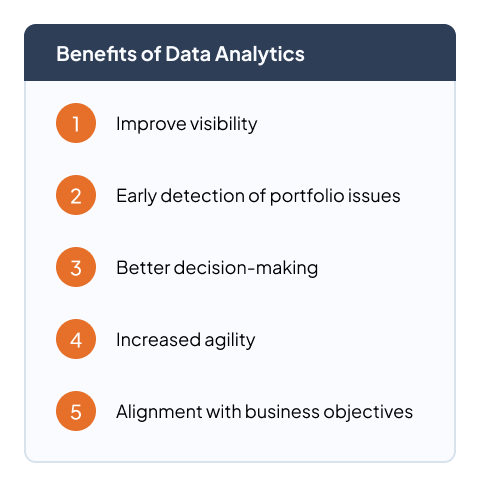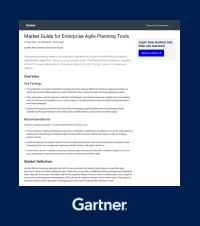10 Project Portfolio Management (PPM) Trends for 2024

What are the latest PPM trends? In 2024, PMOs, IT departments and NDP teams will face new and challenging governance and management challenges. And, in order to face them successfully, it’s necessary to be at the forefront in terms of processes and Project Portfolio Management.
Adopting hybrid management approaches, streamlining Demand Management Processes or integrating Capacity Planning into your Resource Management processes are some of the trends you will need to implement in 2024. What about the others? Find out for yourself in this post.
TABLE OF CONTENTS
- Hybrid management approach
- Integrate PPM with corporate strategy.
- Adaptive Portfolio Management.
- Customer collaboration and stakeholders engagement.
- Embracing P2P: shifting from Projects to Products.
- Streamlining of demand management processes.
- Include capacity planning in resource management processes.
- Cost optimization and value realization.
- Use of data analytics for better decision making.
- Integration of PPM tools with enterprise systems.
- Conclusion.
- Request a demo of Triskell.
1. Hybrid management approach
This is a fact that cannot be ignored. In almost all organizations, two or more management models coexist. Agile, Waterfall or Scaled Agile methodologies are just a few of them. And, depending on the type of projects or programs you manage, there will be times when an Agile management model will work best and others when the more traditional management model will be the best option.
Agile is clearly gaining millions of advocates and is expanding beyond IT and Development teams. But it’s also clear that Agile doesn’t have to work in every context. Not all departments can be 100% agile, and there are certain industries whose processes require more traditional management methodologies.In addition, there are more and more types of portfolios (products, investments, services, applications, IT assets, applications, etc.), which require different management methodologies depending on each case.
Within a customer-oriented project, the product delivery part can be managed in Agile.
Therefore, hybrid project management are the future of PPM. More and more companies are understanding that their market competitiveness depends on knowing how to adapt to the ever-changing environment we are living in. And that means embracing management models that take the best of the most traditional management approaches and the new agile methodologies.
2. Integrate PPM with corporate strategy
Completing projects and programs on time and on budget are no longer the only success factors in project management. Aligning portfolio management with strategic objectives is a major challenge for companies today. Project Portfolio management must therefore be focused on the continuous value delivery for both, organization and customers /users.
This integration is not limited to scoring projects and programs according to their strategic importance but must go one step further. All processes related to Resource Management, Demand Management or Financial Management of the Project Portfolio must be aligned with Strategic Planning. In addition, it is key for successful strategy execution to effectively communicate the strategy and involve the teams in the prioritization process of projects and initiatives.
There is a growing number of PPM tools on the market with Strategic Portfolio Management capabilities. These are solutions capable of transforming the strategic objectives into project plans, products and services focused on value delivery for the business in an Agile and flexible manner.
Triskell brings together the best of PPM tools with features for Strategic Portfolio Management.
3. Adaptive Portfolio Management
We are living in very turbulent times. Political conflicts or the financial instability are affecting the strategic planning of all corporations. Many are forced to change strategic planning on the fly. And it is here, when it comes to adapting strategy execution to these changes, where many organizations fail.
Both strategy planning and execution must be adaptive. This will enable companies to optimize their project and product portfolios and ensure that the ROI expected for each of them is not compromised by possible strategic realignments.
Today’s PMOs must be adaptive. They must align Project Portfolio Management with the organization’s objectives and respond efficiently to strategic changes. Good practices such as planning capacity 3 to 6 months ahead or reviewing the priority of incoming demands will bring you many benefits, for example:
- More effective Risk Management.
- Faster delivery times.
- Reduced costs.
- Higher customer and user satisfaction.
- Lower project and product portfolio volatility.

See the Triskell platform in action in a personal demo
4. Customer collaboration and stakeholders engagement
Engaging customers and stakeholders is one of the most important project portfolio management trends to keep in mind. Taking both actors into account is key to the success of today’s organizations for the following reasons:
- Better alignment with business objectives:
By knowing stakeholders’ and users’ needs, companies can better understand their problems and pain points. And, therefore, they can implement initiatives that meet their needs. For example, launch a new product, improve customer service, increase the network of partners, reduce infrastructure costs, etc. - Improved decision-making: This active listening to customers and stakeholders can provide valuable feedback and insights that can lead to more accurate and realistic decision-making.
- Better risk management: Customer and stakeholder involvement in Project Portfolio Management processes will improve Risk Management, as the chances of a project or product failure will be significantly reduced.
In order to facilitate this collaboration you can use a PPM software with Demand Management capabilities. This will improve your internal communication with them throughout all project lifecycle phases and enable both stakeholders and internal customers to formalize their project requests.
Involve customers and stakeholders especially in the initial and testing phases of your projects
5. Embracing P2P: shifting from Projects to Products
As Agile and adaptive elements are incorporated into portfolio management, your delivery model will evolve as well. While more traditional portfolio management approaches focus on project delivery, more and more organizations have adopted more product-centric delivery models to improve agility and focus on value.
And the question here is: how do the two models differ?:
- Project delivery: teams are organized around projects, and only own specific initiatives or tasks. Once these come to an end and new projects are demanded, then new teams are reorganized in order to meet these new challenges.
- Product delivery teams are organized around products. A single multidisciplinary team is created that ultimately owns all aspects related to that product (design, development, budget, market research, technical support, etc). They are able on their own to solve problems and improve the product as users’ needs evolve.
This new product-centric approach helps companies stay competitive in their industries by enabling them to create new products faster and spot opportunities to improve the existing ones. And where aspects such as Continuous Improvement, active listening to customers and methodologies such as Lean Portfolio Management or Phase-Gate are key to success.

6. Streamlining of demand management processes
Streamlining Demand Management is one of the biggest challenges for IT departments in medium and large companies. Many organizations still do not have centralized demand repositories, which is essential to gain visibility over the entire volume of incoming demand.
But centralizing incoming demand is only the first step in aligning Demand Management with Strategic Planning or Resource Management. Organizations must expedite the Demand Management process to accelerate value delivery and improve decision-making about which demand requests should or should not be prioritized.
To this end, some of the following strategies should be followed:
- Automate manual tasks such as data collection and analysis of incoming demand.
- Standardize processes, thus gaining efficiency and reducing the time and resources required to perform all activities related to Demand Management (Demand Planning, Demand Prioritization, Demand Modeling, etc.).
- Data Analytics & Business Intelligence: data analysis tools should be used to identify patterns and trends in incoming demand to improve decision-making.
- Integrate Continuous Improvement into Demand Management processes, so that they do not lose effectiveness and efficiency over time.
7. Include capacity planning in resource management processes
Another benefit of streamlining Demand Management directly involves this other Project Portfolio Management Trend. By streamlining and centralizing this process, you will have full visibility of all incoming demand, making capacity planning easier.
As you may already know, capacity planning is about forecasting the resources and skills required to meet all the demand for a given period of time. Having a solid capacity planning process in place will therefore help you to have the right resources to meet your organization’s needs.
Plan capacity 3 to 6 months ahead based on volume and demand trends in your organization
Leverage what-if scenarios analysis to get the most out of Capacity Planning. And, once this process is optimized, your teams will be able to focus on the projects and initiatives that really add value. You will detect resource gaps in the organization early, and you will reduce resource constraints.
8. Cost optimization and value realization
Project prioritization is one of the most important PMO processes. The volume of projects and initiatives that an organization has to manage is increasing and resources are becoming more and more limited.
Many of these initiatives are also irrelevant to the business. Hence the importance of making the right decisions to prioritize not only those initiatives that really help to meet strategic objectives, but also to prevent the organization from incurring unnecessary costs by allocating resources to tasks that do not add value to the business.
Scoring projects and programs based on the value they bring to the business will ensure that issues such as Financial Management, Resource Management or Risk Management are aligned with strategic objectives. In short, a Lean Portfolio Management model that will make the PMO always keep value delivery in mind.
See the Triskell platform in action in a personal demo
9. Use of data analytics to inform decision making
Having full visibility and control over project and product portfolios is becoming increasingly complicated due to the enormous amount of data generated. And it can be time-consuming if you still manage the PPM of your organization with spreadsheets.

Using tools for real-time data analysis will allow you to make business-relevant decisions very quickly, and respond to changes in strategic planning and project portfolio management efficiently. Because integrating data analysis and Business Intelligence will only bring benefits to your organization, such as:
- Real-time visibility: you will get real-time information on the status of all projects and programs, allowing you to make informed decisions on issues such as Resource Management, Risk Management or project prioritization.
- Early detection of issues: by monitoring your project portfolio data in real time, you will be able to timely identify issues that may compromise the performance of key projects or the financial health of the organization.
- Better alignment with strategic objectives: data analytics will provide you with the information you need to support your decisions with real-time data.
10. Integration of PPM tools with enterprise systems
It is useless to try to implement all these trends in Project Portfolio Management if you then have all the information fragmented in different applications. Many organizations still use multiple systems to record and manage their project portfolios. If having control of all this information is already complex in itself, imagine having to do it from solutions that are not integrated with each other. Absolute mess, isn’t it?
The more applications and functionalities you can integrate into the PPM tool you use for Project and Product Portfolio Management, the better. Tracking and recording information will not only be easier, but you will gain in productivity by not wasting so much time entering data manually. It will also improve your decision-making process and the visibility on all projects and initiatives you are working on.
By integrating PPM tools with enterprise systems, you will improve productivity and break down silos
Conclusion: Move your PMO forward with these PPM Trends
As your company’s objectives change, new work methodologies and new trends in the field of portfolio management will emerge over time that you will need to take into account in order for your organization to remain competitive in your market.
Completing projects and programs on time and on budget is no longer the only critical success factor in Project Portfolio Management. The key now is to connect execution with strategy, and to have the processes, tools and knowledge bases in place to ensure value delivery and continuous improvement.
In short, The important thing is not that you know all the trends, or that you apply them all at the same time. You should evaluate, based on the nature of your organization, which of them will bring you positive results in your daily performance. And, of course, to have tools that are flexible and adaptable enough to allow you to implement these new trends.
Subscribe to our Newsletter
Get stories like this in your inbox
Request a demo of Triskell Software
Triskell Software is the flexible solution you need to drive your organization’s portfolio management to excellence. Check it out for yourself by requesting a demo below.

FAQs about trends in project
portfolio management
How can I leverage AI and automation in project portfolio management?
AI and automation can be applied in PPM in various ways, such as:
- Automating repetitive tasks like resource scheduling and risk assessment.
- Using AI algorithms to predict project risks and identify potential roadblocks.
- Gaining insights from historical project data to improve future project planning and portfolio selection.
What are the benefits of using a hybrid approach to project portfolio management?
A hybrid approach offers the following advantages:
- Increased flexibility: Combines the structured planning of traditional methods with the adaptability of agile methodologies to accommodate changing priorities.
- Improved resource allocation: Provides a holistic view of resources across projects, enabling better allocation and utilization.
- Enhanced innovation: Agile elements within the hybrid approach can foster a culture of innovation and experimentation within project portfolios.
How can I implement data-driven decision making in PPM?
Here are some steps to integrate data into your PPM practices:
- Identify key performance indicators (KPIs) that track project and portfolio health.
- Utilize project portfolio management tools that provide data analytics and reporting capabilities.
- Regularly analyze data to identify trends, assess risks, and make informed decisions about project selection, resource allocation, and portfolio adjustments.
How can I get started with implementing these PPM trends?
Here are some initial steps to embrace these PPM trends:
- Evaluate your current PPM practices: Identify areas for improvement and opportunities to integrate new trends.
- Define your strategic goals: Align your PPM approach with your organization’s overall objectives.
- Invest in the right tools and technologies: Consider PPM software solutions that support desired functionalities like AI and data analytics.
- Train your teams: Equip your teams with the skills and knowledge needed to adopt new PPM practices effectively.
Related Content

Why the CIO needs a PMO approach
Unlock business success: discover why the CIO must embrace a PMO approach! to elevate efficiency and boost productivity.

Lean Budgeting for Agile Portfolios: A Comprehensive Guide
Lean Budgeting: the financial revolution for Agile portfolios. Discover how to streamline project financing and optimize value delivery.

Implementing SAFe with a 7-step roadmap
Do you want to scale Agile at the enterprise level and don’t know where to start? We solve your doubts by explaining the steps to implement SAFe.

